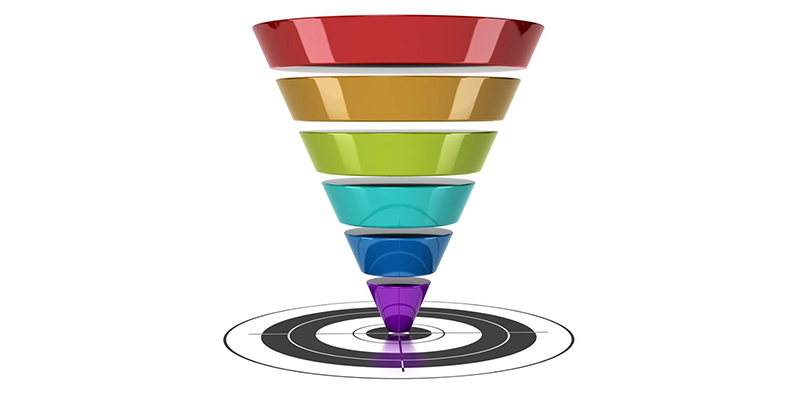How to Look at Analytics for eCommerce Sites
Almost no one likes to analyze data. That’s what makes analysis so profitable.
Online store owners don’t need to become data scientists to turn their data into profit either. It is a simple matter of looking at what is working well, and what isn’t working so well.
We do this naturally in our daily lives. We are attracted to gain; we shy away from loss. But most eCommerce merchants don’t know where to look, or how to interpret gain and loss from online marketing channels.
Some basic analytics will not only reveal the troublesome areas of your online business, but they will point you towards the right channels, where invested resources will gain maximum effect.
Using a Funnel as the Backbone of a Basic Analytics Strategy

The first step is to understand how marketing works. And for decades, advertisers have understood campaign efficacy as a funnel.
The concept behind a funnel is that a campaign has the most reach at its first stage, where the most prospective customers see the brand. Then, only some prospects continue to the next stage in the funnel, leaving others to drop off. The fewest customers will actually make a purchase. For example:
- You hire an influencer to tweet your daily deal to her 50,000 followers.
- Out of her 50,000 followers, 5,000 click on the link.
- Out of those 5,000, only 500 remain on your site after 5 seconds.
- Out of those 500, 250 click the link of the product to see the description.
- Out of those 250, 100 place the item in their cart.
- Out of those 100, 50 check out.
From this simple funnel, we are able to note a couple things. From step 1, we see that 10% of the influencer’s fans clicked on the link. Would trying a different influencer yield better results? How about a different influencer with a different demographic of fans? Step 3 at the funnel reveals that your site has a bounce rate of 90%, which is above average, which could mean that some changes to the landing page might double or triple your takeaway.
The funnel allows you to isolate specific stages and focus your attention where it’s needed to have the greatest impact. All of these can be revealed by looking at Google Analytics (or Twitter Analytics for Step 1-2). This is what we’re going to show you how to do next.
The Good Kind of Traffic

Google Analytics allows you to understand how traffic finds your website. This is the most challenging stage for most eCommerce retailers, so this is where we’ll start.
Online traffic is divided in four different categories based on origin. Organic search, referral, social, and direct all provide users information on which promotional channels are being utilized, how well that specific channel is doing, and ultimately how likely that traffic is to make a purchase.
Organic Search traffic comes from search engines across the board, but mostly Google, Bing, and Yahoo. If your business has committed to a long-term SEO campaign, this is the traffic you will want to monitor as your pages start ranking in the top results. From there, you can understand which pages and keywords are sending the best converting traffic and adjusting strategy to either create more pages or keywords like them, or placing betters calls-to-action in similar but poorly performing pages.
Referral traffic comes from someone clicking a referral link on another website or an email. This is useful to track email campaigns (along a service such as Mailchimp), or how well your links are performing on other sites. If your site or products got featured on a blog, you will be able to see how much traffic is coming from that site.
Social consists of traffic coming to your site through social media networks, such as Facebook, Twitter, Instagram, Pinterest, etc. This would be the type of traffic you would be looking at in the funnel example above with our Twitter influencer.
Direct doesn't exactly have a known origin because it is from people who are manually searching for your site by name. These people are familiar with your brand and are directly searching for you. This sorts of traffic comes after building strong relationships with your customers or having a recognizable brand. The difference between direct and referral traffic can be confusing, but it is essentially this. If someone types www.Nike.com, it is direct. If you click a link to Nike’s site on your friend’s shoe blog, it is referral.
Basic Reports: “Only the penitent will pass.”
No one knows how many Nazi foot soldiers were beheaded before Indiana Jones took a crack at the Holy Grail, but we do know that all he had to do was duck and roll. You don’t need to be a genius to run a basic report in Google Analytics. All you need to do is not run away. Do that, and you can be a hero too.
All it takes is a brief lesson to understand where to find the information you’re looking for. The report categories can be found on the left side menu:
Real-Time allows you to see what is happening on your site in real time. This is useful if you want to check how a campaign is doing at any given moment.
Audience reveals all sorts of information about who is on your site from demographics, location, to even what type of device they are using.
Acquisition provides detailed information about how visitors found your site, and would be extremely useful if you wanted to track the funnel example above.
Behavior provides important information about what visitors are doing once they get on your site. This will reveal which pages are getting the most traffic, and how traffic moves from a landing page to either drop off points, or hopefully the checkout cart.
Conversions allows online store managers to see everything from individual product performance, to sales performance, transactions, and time to purchase. To enable conversion data, you need to set up goals and eCommerce tracking. This is a bit more involved but absolutely worth it.
Measurement is Improvement

Google Analytics hands users virtually any piece of information they would want to know about their site for free, and if you’re not using it (or a compatible sort of analytics) at a basic level you might as well be shooting in the dark. Having this information gives you the edge — not only against your competitors, but against the unknown trenches of the Internet.
Pairing your Google Analytics knowledge with social media analytics, or Shopify eCommerce analytics will give you enough information to take your business to the next level, but it’s up to you to know what to do with it.
Knowing your site inside and out will help you adjust for marketing and consumer preferences ahead of the curve and maneuver accordingly to not only avoid damage, but to capitalize on potential profit that others will be too slow to see.
Related Posts
In an online space where brands relentlessly struggle for more website traffic and sales, creating the right SEO strategy boosts your site's visibility by placing it higher on search engine rankings.
SEO, or Search Engine Optimization, began in the mid-1990s. This was shortly after the world's first search engines debuted, prompting webmasters to optimize their sites for visibility and ranking.
In this comprehensive tutorial on YouTube SEO, we'll discuss how you can rank highly on YouTube with the help of optimizing your YouTube channel and YouTube videos.
Because of the fast lift in internet business and advanced promotions, SEO has turned into all the rage.
I would like to touch on the topic of SEO optimization and discuss the recommendations that experienced SEO experts give. Why are they so interesting?


















Comments
comments powered by Disqus